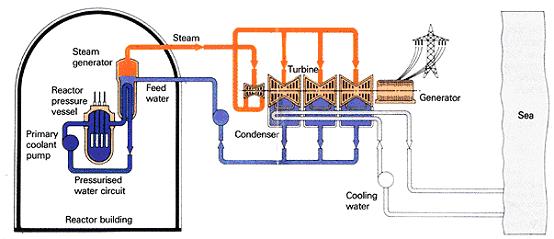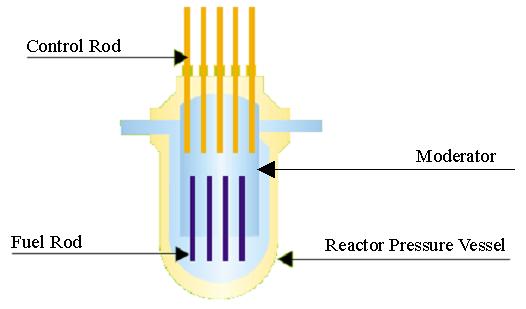l Nuclear energy
As mentioned in the previous section, nuclear activities come along with large amount of energy. The biggest challenge is how we can capture the energy effectively and safely.
Nowadays, nuclear energy is generally regarded as using heat produced by the chain reaction of Uranium-235 to produce electricity. There are many types of nuclear reactors making use of different principles to generate electricity. One common type is the Pressurised Water Reactor (PWR). The basic working principle is that the heat produced by nuclear fission is first carried away by pressurised water to the steam generator. Water from another circuit is boiled by the heat and the steam formed is then used to drive a turbine-generator to produce electricity. Water in the primary circuit is pressurised to raise its boiling point, so that heat can be carried more efficiently.

↑ A Pressurised Water Reactor
The fuel (Uranium-235) undergoes the chain reaction inside the reactor pressure vessel. Besides the fuel rods, there are some more rods called “control rods”, and the whole vessel is filled with a “moderator”.

The high energy neutrons released by fission, fast neutrons, travel at very high speeds. To raise the efficiency of the reactor, the fast neutrons must be slowed down to increase its probability of hitting more uranium atoms and thus inducing more fission. Commercial type nuclear reactors normally use a moderator to slow down the high energy neutrons to low energy neutrons, which are named as thermal neutrons. Ordinary water, graphite and the more expensive heavy water are some examples of moderators used in various types of nuclear reactors.
If the chain reaction is going too fast, the large amount of heat accumulated can cause explosions, so control measures are needed to prevent dangers. In case of emergency, in order to slow down or even stop the chain reaction, control rods can be inserted into the vessel. The materials (typical examples include boron and cadmium) in the control rods can absorb neutrons, and thus stop them from continuing the chain reaction.
Apart from the Pressurised Water Reactor, there are other types of commercial nuclear reactors, including Boiling Water Reactor (BWR), Pressurised Heavy Water Reactor (CANDU), Graphite Moderated, Direct Cycle (Boiling Water) Pressure Tube Reactor (RBMK), etc.